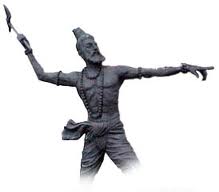Kerala - Myth and Reality
The first mention of the word ‘Kerala’ can be traced to the Asokan era.

Kerala attracted foreigners with its rich aromatic herbs and spices, long years ago, but its yesterdays were shrouded in mystery.

According to Hindu mythology, the ‘trimurtis’—Brahma (the Creator), Vishnu (the preserver) and Shiva (the Destroyer)--are revered. Whenever the world faced a crisis, Vishnu took on the human form and there were ten such incarnations (avatars). Lord Krishna and Lord Rama were believed as manifestations of these forms.
Parsurama, who hived land out from the ocean to create ‘Kerala’, is another such incarnation, therefore Kerala usually sees a prefix ‘Parasurama’s Kerala’.
The Sanskrit history text, ‘Keralamahatmyam’ and a similar treatise in Malayalam, the ‘Keralolpathi’, have references about Parasurama. The legend is that Parasurama requested the sea God for land to meditate and for this he stood at Gokaran and threw his axe into the ocean to hew out a slice of land and thus was emerged ‘Kerala’. This avatar of Lord Vishnu got Brahmins from the north to manage the newly formed region and subordinate castes too. The area did not experience peace because there were bitter struggles between the groups. Under such circumstances the ‘Perumals’ (rulers) from beyond the state were brought to control the region. Each Perumal was given twelve years for administration. The last ruler in that series was Cheraman Perumal whose term had been extended many times.
After repeated extensions were given, the Perumals wanted to relieve himself of the responsibility. He parcelled out the territory to his successors and then went on a pilgrimage to Mecca. While early writers of the history and the 'Keralolpathi' and 'Keralamahatmyam' have relied on these sources, modern historians have considered these as myths.

